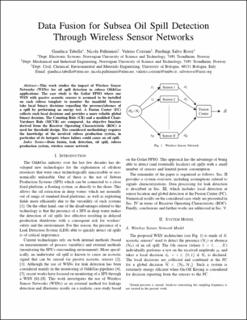Data Fusion for Subsea Oil Spill Detection Through Wireless Sensor Networks
| dc.contributor.author | Tabella, Gianluca | |
| dc.contributor.author | Paltrinieri, Nicola | |
| dc.contributor.author | Cozzani, Valerio | |
| dc.contributor.author | Salvo Rossi, Pierluigi | |
| dc.date.accessioned | 2021-03-26T13:28:14Z | |
| dc.date.available | 2021-03-26T13:28:14Z | |
| dc.date.created | 2021-01-04T00:51:35Z | |
| dc.date.issued | 2020 | |
| dc.identifier.issn | 1930-0395 | |
| dc.identifier.uri | https://hdl.handle.net/11250/2735766 | |
| dc.description.abstract | This work studies the impact of Wireless Sensor Networks (WSNs) for oil spill detection in subsea Oil&Gas applications. The case study is the Goliat FPSO where one WSN with passive acoustic sensors is assumed to be installed on each subsea template to monitor the manifold. Sensors take local binary decisions regarding the presence/absence of a spill by performing an energy test. A Fusion Center (FC) collects such local decisions and provides a more reliable global binary decision. The Counting Rule (CR) and a modified Chair-Varshney Rule (MCVR) are compared. An objective function derived from the Receiver Operating Characteristic (ROC) is used for threshold design. The considered methodology requires the knowledge of the involved subsea production system, in particular of its hotspots whose failure could cause an oil spill. | en_US |
| dc.language.iso | eng | en_US |
| dc.publisher | IEEE | en_US |
| dc.title | Data Fusion for Subsea Oil Spill Detection Through Wireless Sensor Networks | en_US |
| dc.type | Journal article | en_US |
| dc.type | Peer reviewed | en_US |
| dc.description.version | Akseptert | en_US |
| dc.source.journal | Proceedings of IEEE Sensors | en_US |
| dc.identifier.doi | 10.1109/SENSORS47125.2020.9278741 | |
| dc.identifier.cristin | 1864485 | |
| cristin.ispublished | true | |
| cristin.fulltext | postprint | |
| cristin.qualitycode | 1 |
